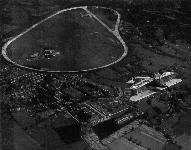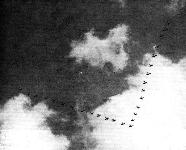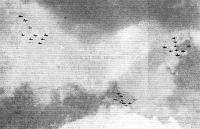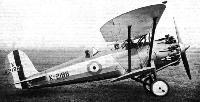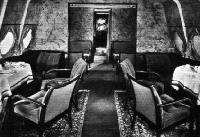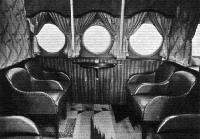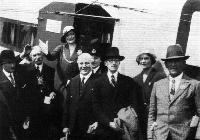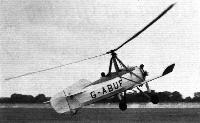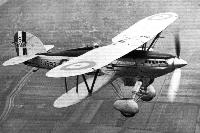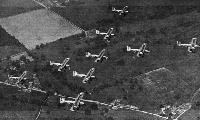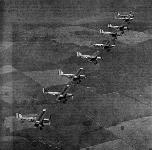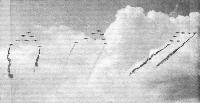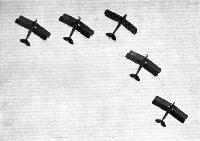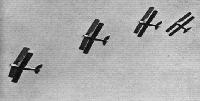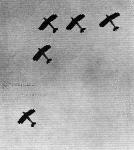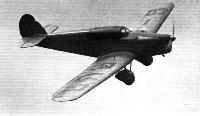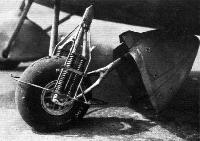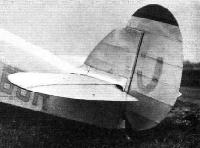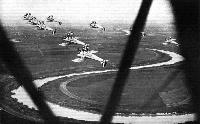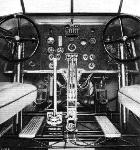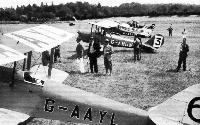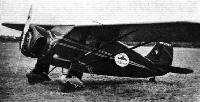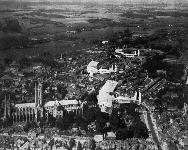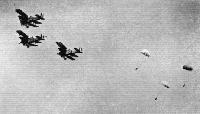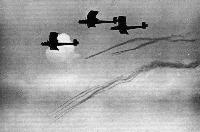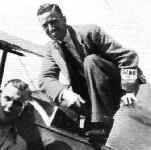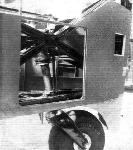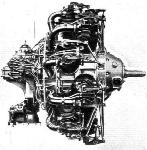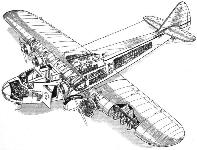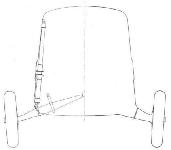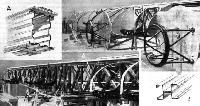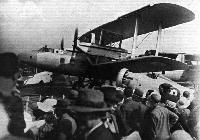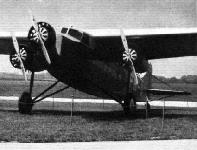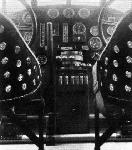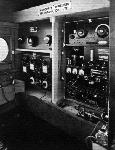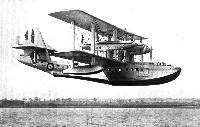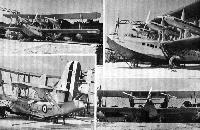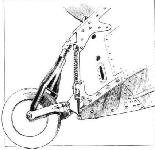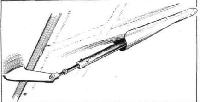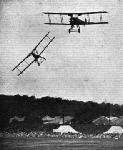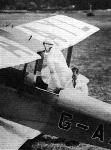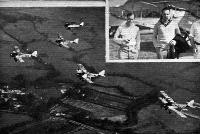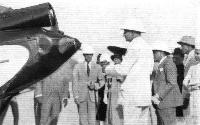Фотографии
-
Регистрационный номер: K1996 TURNING HER BACK ON HOME: A HAWKER "HART" (ROLLS ROYCE) "KESTREL" DOING INVERTED FLYING (PILOT MR. SAYER) NEAR BROOKLANDS. THE WHOLE OF THE "BOWL" CAN BE SEEN IN THE PICTURE, WITH THE HANGARS, CLUB HOUSE, MEMBERS' ENCLOSURE, TEST HILL, ETC. ON THE EXTREME RIGHT, AT THE "FORK," MAY BE SEEN THE HOME OF VICKERS, LTD. IT IS RARELY THAT ENGLISH WEATHER PERMITS OF TAKING PICTURES FROM SUCH A HEIGHT.
Самолёты на фотографии: Hawker Hart - Великобритания - 1928
-
"WING VEE": Twenty-seven "Harts" beginning their demonstration of air drill.
Самолёты на фотографии: Hawker Hart - Великобритания - 1928
-
THE DAY BOMBERS: Nos. 18, 57 and 33 Squadrons (Kestrel-Hart) getting ready for their takeoff. The Auxiliary Wing is just behind them (Jupiter-Wapiti).
Самолёты на фотографии: Hawker Hart - Великобритания - 1928Westland Wapiti - Великобритания - 1927
-
MORE AIR DRILL: Another formation by the "Hart" Wing.
Самолёты на фотографии: Hawker Hart - Великобритания - 1928
-
AIR DRILL: Two of the "Hart" Squadrons during their evolutions.
Самолёты на фотографии: Hawker Hart - Великобритания - 1928
-
"WEAVING": The three Bulldogs," piloted by Martlesham pilots, intertwining their smoke trails.
Самолёты на фотографии: Bristol Bulldog - Великобритания - 1927
-
"GENTLEMEN, YOU MAY SMOKE": Martlesham pilots on "Bulldogs" writing the letters "R.A.F." with coloured smoke.
Самолёты на фотографии: Bristol Bulldog - Великобритания - 1927
-
Регистрационный номер: K2188 FOR ADVANCED TRAINING: The Bristol two-seater "Bulldog" ("Jupiter") was one of the new types demonstrated at the S.B.A.C. Display at Hendon on Monday last.
Самолёты на фотографии: Bristol Bulldog - Великобритания - 1927
-
AIR COMBAT: "Sidestrand" v. "Bulldogs."
Самолёты на фотографии: Boulton Paul Sidestrand / P.29 - Великобритания - 1926Bristol Bulldog - Великобритания - 1927
-
"ICH DIEN": "Prince of Wales' Feathers" formed with smoke.
Самолёты на фотографии: Bristol Bulldog - Великобритания - 1927
-
STILL SMOKING: The three "Bulldogs" in Formation.
Самолёты на фотографии: Bristol Bulldog - Великобритания - 1927
-
Santos-Dumont in his second biplane, "14 bis," on which he made the first public flight in Europe, in 1906. This machine was of the "tail-first" type.
Самолёты на фотографии: Santos-Dumont 14bis - Франция - 1906
-
The picture shows the Santos Dumont "Demoiselle" of 1910, a tiny "Tow-pilot" monoplane of only a little over 16 ft. span. It flew somewhat erratically and was apparently a handful for its pilot.
Самолёты на фотографии: Santos-Dumont Demoiselle - Франция - 1907
-
Самолёты на фотографии: Dornier Do.X - Германия - 1929
-
This view shows how comfortably furnished are the dining saloons.
Самолёты на фотографии: Dornier Do.X - Германия - 1929
-
Few aircraft provide smoking facilities in as pleasant a manner as this.
Самолёты на фотографии: Dornier Do.X - Германия - 1929
-
Регистрационный номер: G-ABHV, G-ABHW A view out of the hangar at Hamble, showing the "Avians," "Cadets," "Atlases" and "Siskins" used by A.S.T.
Самолёты на фотографии: Armstrong Whitworth Atlas / Ajax - Великобритания - 1925Armstrong Whitworth Siskin - Великобритания - 1921Avro Avian / Type 594/616 - Великобритания - 1926Avro Cadet / Type 631/643 - Великобритания - 1932
-
TO VIEW THEIR CITY: The Lord Mayor and Lady Mayoress (Alderman and Mrs. F. G. Foster) about to taste the joys of travelling in an Armstrong Whitworth "Argosy." Air Marshal Sir Geoffrey Salmond is on the Lord Mayor's right.
Самолёты на фотографии: Armstrong Whitworth Argosy - Великобритания - 1926
-
UNORTHODOXY: The Handley Page 38 Night Bomber (two "Kestrel") has fuselage and engines placed under the upper wing.
Самолёты на фотографии: Handley Page Heyford / H.P.38 / H.P.50 - Великобритания - 1930
-
Регистрационный номер: J9131 A NEW VICKERS NIGHT BOMBER: Fitted with two Bristol "Pegasus" engines, this machine is a four-seater of 1,367 sq. ft. wing area and a gross weight of 16,400 lb.
Самолёты на фотографии: Vickers Vanox / Type 150 / 195 / 255 - Великобритания - 1929
-
Регистрационный номер: G-ABUF "UP AND AWAY": Mr. Brie lifting the "Autogiro" from the ground for a steep climb when competing at Brooklands on Sunday.
Самолёты на фотографии: Cierva/Avro C.19 - Великобритания - 1929
-
THE FIRST FOCKE-WULF "AUTOGIRO." Of the C.19, Mark IV, type, this machine is fitted with a Siemens-Halske 7-cylinder radial engine of 110 h.p. The first test flights were carried out by Capt. A. H. C. Rawson, and will now be continued by the Focke-Wulf and D.V.L. pilots.
Самолёты на фотографии: Cierva/Avro C.19 - Великобритания - 1929
-
THE FIRST FOCKE-WULF "AUTOGIRO." The engine-driven rotor starter, pyramid and rotor head.
Самолёты на фотографии: Cierva/Avro C.19 - Великобритания - 1929
-
THE CURTISS "CONDOR": A commercial version of the American "Condor" night bomber. It has two 600 h.p. Curtiss "Conqueror" engines and is fitted with a Sperry "Automatic Pilot." Accommodation is provided for 18 passengers and a crew of 3. Its speed range is 57-139 m.p.h.
Самолёты на фотографии: Curtiss Condor 18 - США - 1929
-
Регистрационный номер: S1592 THE FLEET FIGHTER: The Fairey "Firefly III M" (Rolls-Royce "Kestrel") has been designed as a single-seater fighter for work with the Fleet Air Arm. On this occasion it was being piloted by Mr. Staniland. Fairey's Chief test pilot.
Самолёты на фотографии: Fairey Firefly - Великобритания - 1925
-
THE SIGN OF THE CROSS: Hawker "Furies" ("Kestrel") of No. 43 (Fighter) Squadron showing one of their ten formations.
Самолёты на фотографии: Hawker Fury - Великобритания - 1931
-
IN LINE ABREAST: No. 43 (Fighter) Squadron in another of their formations.
Самолёты на фотографии: Hawker Fury - Великобритания - 1931
-
"A.A.F.": Spelled by the Auxiliary Air Force Wing.
Самолёты на фотографии: Westland Wapiti - Великобритания - 1927
-
HOME AGAIN: The "Wapitis" of the three London A.A.F. Squadrons returning after their display.
Самолёты на фотографии: Westland Wapiti - Великобритания - 1927
-
Регистрационный номер: G-ABXW FOR THE CLYDE-BELFAST SERVICE: The Saro "Cloud" amphibian of British Flying Boats, Ltd., being christened Cloud of Iona by the Duchess of Hamilton - supported by Mr. John Lord and Sir Alliott Verdon Roe - at Cowes. As previously reported in "Flight," B.F.B., Ltd., will operate services between the Clyde and Belfast, and in other parts of Scotland. The service to the Isle of Man, previously planned, is for the moment held up pending arrangements for landing at Douglas, where British Amphibious Air Lines, Ltd., hold sole landing rights in the Bay in connection with their service between Liverpool and the Island.
Самолёты на фотографии: Saunders-Roe Cloud / A.19 - Великобритания - 1930
-
Регистрационный номер: N230 FOR No. 100 (BOMBER) SQUADRON: The Vickers "Vildebeest" Torpedoplane ("Pegasus").
Самолёты на фотографии: Vickers Vildebeest / Type 132 - Великобритания - 1928
-
INVERTED FLYING: "Tiger Moths" from C.F.S. In the photograph the leader is inverted and the others "right way up."
Самолёты на фотографии: De Havilland Tiger Moth / D.H.82 - Великобритания - 1931
-
LINING UP FOR THE TORTOISE RACE: Four "Tiger Moths" getting ready for the slow-flying race.
Самолёты на фотографии: De Havilland Tiger Moth / D.H.82 - Великобритания - 1931
-
INVERTED FLYING: "Tiger Moths" from C.F.S. All five machines are upside down.
Самолёты на фотографии: De Havilland Tiger Moth / D.H.82 - Великобритания - 1931
-
Регистрационный номер: G-ABKW "NEW AND EXPERIMENTAL": In front the Fairey Night Bomber (two "Kestrel"), and behind it the new Blackburn ten-passenger machine (two "Jaguar").
Самолёты на фотографии: Blackburn CA.15 Monoplane/Biplane - Великобритания - 1932Fairey Hendon - Великобритания - 1930
-
Регистрационный номер: G-ABUR [3] THE PERCIVAL "GULL" (HERMES IV): This is a new type, with seating accommodation for pilot and two passengers.
Самолёты на фотографии: Percival Gull - Великобритания - 1932
-
Регистрационный номер: G-ABUR [3] Самолёты на фотографии: Percival Gull - Великобритания - 1932
-
Регистрационный номер: G-ABUR [3] A VERY FAST THREE-SEATER: The Percival "Gull" did not get a place in the King's Cup, but it put up a very good performance. The new "Hermes IV" inverted engine gave no trouble whatever.
Самолёты на фотографии: Percival Gull - Великобритания - 1932
-
ACCESSIBILITY: A view of the "Hermes IV" engine as installed in the "Gull." On the right, a view into the cabin, showing the staggered seats.
Самолёты на фотографии: Percival Gull - Великобритания - 1932
-
THE UNUSUAL UNDERCARRIAGE: Each wheel is carried on a fork composed of four members, the ends of the axle having their bearings in crossheads. The landing shock is absorbed by the coil springs, and the bouncing is checked by oil dashpots. Our illustration shows the "spat" removed.
Самолёты на фотографии: Percival Gull - Великобритания - 1932
-
AND THE ORTHODOX TAIL: A view of the tail surfaces, which are of a perfectly normal design and construction.
Самолёты на фотографии: Percival Gull - Великобритания - 1932
-
WITH WINGS FOLDED: The trailing edges of the inner wing portions hinge upwards to permit the wings to be folded back. No jury struts are required, the hinges being strong enough to take the weight of the wings. The petrol and oil tanks are housed in the wing and roots respectively.
Самолёты на фотографии: Percival Gull - Великобритания - 1932
-
EFFICIENCY: This front view of the Percival "Gull" helps to explain why the machine has such a high performance.
Самолёты на фотографии: Percival Gull - Великобритания - 1932
-
"QUICK OFF THE MARK": Mr. A. B. Gibbons using his Pobjoy engine to pull his "Klemm" off the ground in 49 ft. at Brooklands last Sunday.
Самолёты на фотографии: Klemm L.25 - L.28 Swallow - Германия - 1927
-
UPSIDE DOWN IN ITALY: A formation of Breda 19 biplanes flying upside down above the Tiber, on the occasion of the recent Royal Italian Air Force Display.
Самолёты на фотографии: Breda Ba.19 / Ba.25 / Ba.28 - Италия - 1930
-
Two interior views of the cabin of the Caproni "Nord-Africa." On the left, looking aft, showing at the extreme rear the 2nd Class compartment. On the right, looking forward, showing the wireless installation in forward left-hand corner.
Самолёты на фотографии: Caproni Ca.101 - Италия - 1930
-
The pilots' cockpit of the Caproni 101 "Nord-Africa.'' The engine control levers and brake lever are seen between the seats.
Самолёты на фотографии: Caproni Ca.101 - Италия - 1930
-
Caproni 101 Type "Nord-Africa" One 400 h.p. Bristol "Jupiter", Two 210 h.p. Armstrong Siddeley "Lynx"
Самолёты на фотографии: Caproni Ca.101 - Италия - 1930
-
Регистрационный номер: G-ABDH "STAGE AND SCREEN": The inaugural meeting of the Stage and Screen Aero Club was held at Hatfield Aerodrome on Sunday, July 24. The de Havilland School Clubhouse was the venue. In the foreground is the demonstrator "Puss Moth" of Brian Lewis, Ltd. Flt. Lt. Comper showed off a "Swift" (Gipsy III) during the afternoon.
Самолёты на фотографии: De Havilland Puss Moth / D.H.80 - Великобритания - 1929
-
R.A.F. v. NAVY: Lt. Caspar John, R.N., and Flt. Lt. Hattersley off Friday morning.
Самолёты на фотографии: De Havilland Puss Moth / D.H.80 - Великобритания - 1929
-
Регистрационный номер: G-AAYL [2], G-ABLG, G-ABUW ON THE STARTING LINE, SATURDAY: In the foreground, Miss Spooner's "Moth," and beyond that, the Blackburn B.2, Lord Douglas-Hamilton's "Moth" and Mr. Runciman's "Puss Moth."
Самолёты на фотографии: Blackburn B-2 - Великобритания - 1931De Havilland Gipsy Moth / Moth X - Великобритания - 1928De Havilland Puss Moth / D.H.80 - Великобритания - 1929
-
Регистрационный номер: G-ACBR, K3488 A PRIVATE VENTURE: The Westland "P.V.6" ("Pegasus") is a general purpose aircraft.
Самолёты на фотографии: Westland Wallace / PV.3 / PV.6 - Великобритания - 1931
-
Регистрационный номер: D-2500, D-APIS A NEW VERSION OF THE JUNKERS G.38: The "D 2500" which has just been put into service on the Berlin-London route by Luft Hansa. It has accommodation for 34 persons.
Самолёты на фотографии: Junkers G 38 - Германия - 1929
-
Регистрационный номер: NC12157 The Vacuum Oil Co. have recently purchased a Stinson Model "R" (215 H.P. Lycoming engine) which seats 4 persons in great comfort. This aircraft will be used by Mr. J. H. White, in the course of his travels in the Eastern Hemisphere as Aviation representative for the vast vacuum oil interests.
Самолёты на фотографии: Stinson Detroiter / Junior - США - 1927
-
Регистрационный номер: K1175 OXFORD LOOKS DOWN ON CANTERBURY: The O.U.A.S. "Atlas" machines find a natural attraction in beautiful old cities and buildings.
Самолёты на фотографии: Armstrong Whitworth Atlas / Ajax - Великобритания - 1925
-
DROPPING SUPPLIES: Three Armstrong-Whitworth "Atlas" ("Jaguar") of No. 16 (Army Co-operation) Squadron.
Самолёты на фотографии: Armstrong Whitworth Atlas / Ajax - Великобритания - 1925
-
A formation of Armstrong-Whitworth "Atlas" machines of O.U.A.S. flying along the coast of the Isle of Sheppey.
Самолёты на фотографии: Armstrong Whitworth Atlas / Ajax - Великобритания - 1925
-
Регистрационный номер: G-ABVE THE ARROW "ACTIVE II" (GIPSY III): A development of the "Active I," this machine is, apart from its clean design, remarkable for its fine construction.
Самолёты на фотографии: Arrow Active - Великобритания - 1931
-
Регистрационный номер: G-ABJM THIRSTY HORSES: Fuelling the "Panther" engine of the Avro "Mailplane" which scored the fastest time over the course with 176 m.p.h.
Самолёты на фотографии: Avro Mailplane / Type 627 - Великобритания - 1931
-
THE BLACKBURN "B2 TRAINER" (GIPSY III): Differing from the "Bluebird" in its all-metal fuselage, the "B2" shows other improvements on the older type.
Самолёты на фотографии: Blackburn B-2 - Великобритания - 1931
-
LOW BOMBING: Three Vickers "Virginias" ("Lions") of No. 9 (Bomber) Squadron dropping smoke bombs on a ground target.
Самолёты на фотографии: Vickers Virginia - Великобритания - 1922
-
THE PRINCE OF WALES' ENTRY: The "Gipsy Swift" taxying in after securing second place.
Самолёты на фотографии: Comper Swift / CLA.7 - Великобритания - 1930
-
THE PRINCE OF WALES' ENTRY: The "Gipsy Swift" is being groomed.
Самолёты на фотографии: Comper Swift / CLA.7 - Великобритания - 1930
-
Регистрационный номер: G-ABWW THE TWO COMPER "SWIFTS" ("GIPSY III") Fielden and Styran getting away on Friday morning.
Самолёты на фотографии: Comper Swift / CLA.7 - Великобритания - 1930
-
THE "HAT TRICK": For the third time the race for the King's Cup has been won by Mr. W. L. Hope, who was flying a de Havilland "Fox Moth" fitted with the new de Havilland "Gipsy III A" engine. The picture shows Hope crossing the finishing line.
Самолёты на фотографии: De Havilland Fox Moth / D.H.83 - Великобритания - 1932
-
Регистрационный номер: G-ABUT [2] FITTED WITH A NEW ENGINE: The de Havilland "Fox Moth" to be piloted by Capt. Hope has the new "Gipsy IIIA" engine which recently passed its type tests.
Самолёты на фотографии: De Havilland Fox Moth / D.H.83 - Великобритания - 1932
-
Регистрационный номер: G-ABUT [2] THE "HAT TRICK": For the third time the race for the King's Cup has been won by Mr. W. L. Hope, who was flying a de Havilland "Fox Moth" fitted with the new de Havilland "Gipsy III A" engine. The picture shows the machine taxying in.
Самолёты на фотографии: De Havilland Fox Moth / D.H.83 - Великобритания - 1932
-
THE "HAT TRICK": For the third time the race for the King's Cup has been won by Mr. W. L. Hope, who was flying a de Havilland "Fox Moth" fitted with the new de Havilland "Gipsy III A" engine. Hope is seen getting out of the machine.
Самолёты на фотографии: De Havilland Fox Moth / D.H.83 - Великобритания - 1932
-
Регистрационный номер: G-ABPI [6], VT-AEF [6] RUNNING UP: Mr. Campbell-Orde testing his "Double Mongoose" engines before making a flight at Whitley.
Самолёты на фотографии: Armstrong Whitworth Atalanta / A.W.15 - Великобритания - 1932
-
Регистрационный номер: G-ABPI [6], VT-AEF [6] SIDE VIEW OF THE "ATALANTA": Note the "spats" over the wheels, and the low ground clearance.
Самолёты на фотографии: Armstrong Whitworth Atalanta / A.W.15 - Великобритания - 1932
-
Регистрационный номер: G-ABPI [6], VT-AEF [6] THE A.W. XV IN THE AIR: This front view indicates the very low frontal area of the machine.
Самолёты на фотографии: Armstrong Whitworth Atalanta / A.W.15 - Великобритания - 1932
-
Регистрационный номер: G-ABPI [6], VT-AEF [6] THE "ATALANTA" IN FLIGHT: This view from above gives a good idea of the plan form, and also shows the neat merging of the engine housings into the wing surface.
Самолёты на фотографии: Armstrong Whitworth Atalanta / A.W.15 - Великобритания - 1932
-
Регистрационный номер: G-ABPI [6], VT-AEF [6] FOR THE AFRICAN AIR ROUTE: The Armstrong Whitworth "Atalanta" (four Armstrong-Siddeley "Double Mongoose") is the first of eight machines being built for Imperial Airways, Ltd. The extremely careful streamlining should be noted.
Самолёты на фотографии: Armstrong Whitworth Atalanta / A.W.15 - Великобритания - 1932
-
Регистрационный номер: G-ABPI [6], VT-AEF [6] Members of the Chartered Surveyors Institution at the Armstrong-Whitworth Aircraft Factory at Coventry. The aircraft in the hangar is the new AW.XV "Atalanta" built for the Imperial Airways' African route.
Самолёты на фотографии: Armstrong Whitworth Atalanta / A.W.15 - Великобритания - 1932
-
THE TAIL WHEEL: This is of the castor type, and has a very short travel. Details of the tail-trimming gear can also be seen.
Самолёты на фотографии: Armstrong Whitworth Atalanta / A.W.15 - Великобритания - 1932
-
THE ARMSTRONG-SIDDELEY "DOUBLE MONGOOSE": At a normal speed of 2,000 r.p.m. it develops 340 h.p. at 4,000 ft. altitude. Max. power is 375 h.p. at 2,200 r.p.m.
Самолёты на фотографии: Armstrong Whitworth Atalanta / A.W.15 - Великобритания - 1932
-
Самолёты на фотографии: Armstrong Whitworth Atalanta / A.W.15 - Великобритания - 1932
-
REDUCING UNDERCARRIAGE DRAG: Schematic representation of how most of the undercarriage is "buried" inside the fuselage.
Самолёты на фотографии: Armstrong Whitworth Atalanta / A.W.15 - Великобритания - 1932
-
The front spar, with bearers for engines and petrol tanks. The insets show sections of spar booms and ties.
Самолёты на фотографии: Armstrong Whitworth Atalanta / A.W.15 - Великобритания - 1932
-
THE METAL RIBS: These are used in the central portion of the wing only, the other ribs being of wood.
Самолёты на фотографии: Armstrong Whitworth Atalanta / A.W.15 - Великобритания - 1932
-
THE SERVO RUDDER ARRANGEMENT: For small angles the rudder is operated direct. For larger angles the Servo rudder comes into action.
Самолёты на фотографии: Armstrong Whitworth Atalanta / A.W.15 - Великобритания - 1932
-
A.W.XV. 4 Double Mongoose Engines
Самолёты на фотографии: Armstrong Whitworth Atalanta / A.W.15 - Великобритания - 1932
-
Регистрационный номер: J9832 DIGNITY AND IMPUDENCE: The Gloster Troop Carrier and the Vickers "Jockey" emerging from the aircraft park.
Самолёты на фотографии: Gloster TC.33 Goshawk - Великобритания - 1932Vickers Jockey / Type 151 - Великобритания - 1930
-
THE FOKKER F.XVIII: The engines are Pratt & Whitney "Wasps" of 440 h.p. each. They are fitted with Townend rings.
Самолёты на фотографии: Fokker F.IX / F.XII / F.XVIII - Нидерланды - 1929
-
Регистрационный номер: PH-AIP Three-quarter front view of the Fokker F.XVIII.
Самолёты на фотографии: Fokker F.IX / F.XII / F.XVIII - Нидерланды - 1929
-
IN THE CABIN OF THE F.XVIII: On the left a view looking aft. Note the pantry, of "easy work" style. On the right a view looking forward. The seats can be turned into couches. The table on the left is the navigator's chart table.
Самолёты на фотографии: Fokker F.IX / F.XII / F.XVIII - Нидерланды - 1929
-
Looking into the pilots' cockpit of F.XVIII. The circles on the backs of the seats are lightening holes and not instruments!
Самолёты на фотографии: Fokker F.IX / F.XII / F.XVIII - Нидерланды - 1929
-
THE MICHELIN CUP WINNER: The Hanriot 41 Monoplane (230-h.p. Lorraine air-cooled radial).
Самолёты на фотографии: Hanriot LH.41 / LH.130 / LH.131 - Франция - 1930
-
STEAM COOLING: A Supermarine "Southampton" (two Rolls-Royce "Kestrel") has been fitted experimentally with steam cooling, which accounts for the small size of the radiators.
Самолёты на фотографии: Supermarine Southampton / Solent - Великобритания - 1925
-
Marconi light-weight telephone equipment. Type A.D. 22B, fitted in Mrs. Victor Bruce's "Windhover."
Самолёты на фотографии: Saunders-Roe Windhover / A.21 - Великобритания - 1930
-
The Marconi A.D.18A equipment in the Morris 10 cwt. The long-wave receiver is on the left and the transmitter and short-wave receiver on the right.
Самолёты на фотографии: Saunders-Roe Windhover / A.21 - Великобритания - 1930
-
Регистрационный номер: S1589 [4] THE NEW 6-ENGINED SHORT FLYING BOAT (ROLLS-ROYCE "BUZZARDS"): Although launched only a fortnight ago, the boat could be demonstrated with every confidence on Monday last. It was flown by Mr. Lankester Parker. Like other Short flying boats, the new machine was "right" from the very start, and needed practically no modifications at all.
Самолёты на фотографии: Short Sarafand / S.14 - Великобритания - 1932
-
Регистрационный номер: S1589 [4] Самолёты на фотографии: Short Sarafand / S.14 - Великобритания - 1932
-
Регистрационный номер: S1589 [4] IN HER HOME WATERS: The Short six-engined flying boat ("Buzzards") at Moorings on the Medway. The official designation of this boat is "Flying Boat R.6/28."
Самолёты на фотографии: Short Sarafand / S.14 - Великобритания - 1932
-
Регистрационный номер: S1589 [4] THE LATEST OPEN SEA RECONNAISSANCE MULTI-SEATER FLYING-BOAT: This new six-engined Short machine has just been launched at the Rochester works of Short Brothers. The engines are Rolls-Royce "Buzzards."
Самолёты на фотографии: Short Sarafand / S.14 - Великобритания - 1932
-
Регистрационный номер: G-ABTY [3] THE SPARTAN "CRUISER": "Spats" over the wheels add to the already clean design. The engines are de Havilland "Gipsy III."
Самолёты на фотографии: Spartan Cruiser - Великобритания - 1932
-
Регистрационный номер: G-ABTY [3] Самолёты на фотографии: Spartan Cruiser - Великобритания - 1932
-
Регистрационный номер: G-ABTY [3] THE LATEST SPARTAN: This new Spartan is a six-seater with three Gipsy III engines. The wing is of plywood, while the roomy fuselage of "Alclad" closely follows the construction of the Saro "Cutty Sark." Flight tests have been made and the machine is very pleasant to handle.
Самолёты на фотографии: Spartan Cruiser - Великобритания - 1932
-
On the left one of the wing engine mountings. On the right a wing engine installation.
Самолёты на фотографии: Spartan Cruiser - Великобритания - 1932
-
The oil tank of each wing engine is mounted in the fairing behind the engine.
Самолёты на фотографии: Spartan Cruiser - Великобритания - 1932
-
ON THE "CRUISER": The tail wheel, which is sprung and swivelled, the sideways movement being limited by rubber buffers.
Самолёты на фотографии: Spartan Cruiser - Великобритания - 1932
-
ON THE "CRUISER": The aileron crank and its fairing.
Самолёты на фотографии: Spartan Cruiser - Великобритания - 1932
-
Spartan Cruiser 3 Gipsy III Engines
Самолёты на фотографии: Spartan Cruiser - Великобритания - 1932
-
The instructor just avoids collision with his clumsy pupil in the demonstration of instructional flying on Avro-Lynx.
Самолёты на фотографии: Avro Avro 504N - Великобритания - 1920
-
Регистрационный номер: G-AAYL [2] EQUAL TO THE BEST OF THEM: Miss Winifred Spooner gets into her "Moth."
Самолёты на фотографии: De Havilland Gipsy Moth / Moth X - Великобритания - 1928
-
Регистрационный номер: G-AAJJ, G-AARE A formation flight over Stag Lane in "Moths" of the London Aeroplane Club by members of the British Aviation Insurance Co.
Самолёты на фотографии: De Havilland Gipsy Moth / Moth X - Великобритания - 1928
-
A "MOTH" IN LUCKNOW: His Excellency Sir Malcolm Hailey, the Governor of the United Provinces, naming a "Moth" presented to the Delhi and U.P. Flying Club, Lucknow Centre, by the Raja of Nanpara.
Самолёты на фотографии: De Havilland Gipsy Moth / Moth X - Великобритания - 1928
-
IN SEARCH OF THE LOST OASIS: Refuelling Sir Robert Clayton East's "Moth" with "Shell" in the desert, some 150 km. north of Owenat.
Самолёты на фотографии: De Havilland Gipsy Moth / Moth X - Великобритания - 1928
-
The first student members of the College of Aeronautical Engineering Aero Club with their "Moth" (Gipsy I) aeroplane. This Club is organised and run entirely by students of the College, who are training as ground engineers, and is a serious effort by future members of the civil aviation industry to learn everything there is to know about their job. Capt. Duncan Davis and Mr. Lowdell, of Brooklands Aviation, Ltd., are in the centre of the group, by the nose of the "Moth."
Самолёты на фотографии: De Havilland Gipsy Moth / Moth X - Великобритания - 1928
-
THREE "MISSING" ENGINES: The B.A.C. Gliders circling in line astern.
Самолёты на фотографии: Lowe-Wylde Columbus / BAC.II - BAC.IX - Великобритания - 1930
-
The Air Ministry Mail Carrier under construction by Boulton & Paul, Ltd.
Самолёты на фотографии: Boulton Paul Mailplane / P.64 - Великобритания - 1933
Статьи
- Flight
